William Botterill and Son
| Industry | Architectural design |
|---|---|
| Headquarters | Kingston upon Hull |
William Botterill and Son was a prominent Kingston upon Hull architectural practice.
The practice was founded by William Botterill (1820–1903), who worked with his son William Henry Botterill (1851–79), and after 1881 with John Bilson (1858–1943) as Botterill and Bilson.
History[]
William Botterill came to Hull in 1848 as clerk of works for the new and set up an architectural practice in 1851.[1] His son William Henry (1851–79) was also a partner in his practice.[2] John Bilson,[note 1] trained at the practice and became a partner in 1881.[1] Botterill's son William Henry died early in 1879 and Bilson subsequently became the main partner in the practice, taking over the business when Botterill retired in 1899.[3]
The firm's commissions included chapels, houses, banks, offices, industrial buildings:[4][5] commissions included the schools for the , with Botterill initially producing gothic revival designs, and later designs in the Queen Anne revival style by Bilson.[6] Botterill designed the Newland Park Estate in Hull in 1877, though most of its houses were developed after his death.[7] Oriel Chambers (now the home of the Wilberforce Institute for the study of Slavery and Emancipation[2]) were built in 1879.[8] Bilson's work included the Jacobean style Hymers College (1893),[9] the Boulevard Higher Grade School (1895),[10] and classically styled buildings for the built in the 1920s and after.[11]
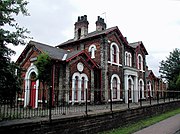
Stepney railway station house, Hull. 1853

Centenary Methodist Chapel, Market Rasen. 1863
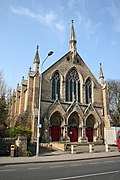
Methodist Chapel, Alford. 1864
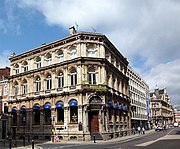
Midland Bank, Hull. 1869–70

Tower Hill Methodist Church, Hessle. 1875-6

Oriel Chambers, Hull. 1879

Newington primary school, Hull. 1885
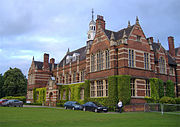
Hymers College, Hull. 1893

Boulevard Higher School, Hull. 1893
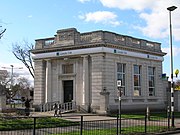
Hull Savings Bank (Derringham Bank branch), Hull. 1936
- Listed and other buildings, non-exhaustive list
William Botterill[]
- Stepney Station House, Hull (1853).[12]
- Centenary Methodist Chapel (1863).[13][14]
- Methodist Chapel and Sunday School, Alford, Lincolnshire. (1864).[15]
- Exchange Buildings, Lowgate, Hull (1866).[16]
- 32, Silver Street, Hull (1869–70).[17]
- Offices. 2, Manor Street, Hull (1870).[18]
- Kings Market, South Church Side, Market Place, Hull (1875).[19]
- Oriel Chambers, Hull (1879).[8]
- Charterhouse School, Hull (1881).[20]
- Newington Primary School (1885) and adjoining nursery (1898), Hull.[21]
- Stepney Infants School, Hull (1886).[22]
John Bilson[]
- Church of All Saints, Bolton Percy, North Yorkshire. (originally 14th century, restored 1905 by Bilson)[23]
- Pickering Hall, Hull (1914)[24]
- Lloyds Bank, Silver Street, Hull (1912).[25]
- Church of St. Helen, Escrick (orig. 1857, restored 1923 by Bilson).[26]
Demolished works[]
- "1882 – Church of St. Phillip, Trippet, Kingston upon Hull, Yorkshire", archiseek.com ; red brick early English gothic revival (built 1881–2)
- Former Methodist Church in Chapel Street, Bridlington ; Weslyan chapel, white brick and stone, neoclassical (built 1873, dem.2004)
See also[]
- Cuthbert Brodrick, Alfred Gelder, contemporary Hull architects
Notes[]
- ^ Bilson is better known for his work as an historian of medieval architecture and is considered one authority on Cistertian architecture. (See main article John Bilson (architect))
References[]
- ^ a b Neave & Neave 2010, p. 19.
- ^ a b "Wilberfoce Institute, Oriel Chambers, venue hire", www2.hull.ac.uk, The History of Oriel Chambers, retrieved 21 June 2014
- ^ "John Bilson", www.scottisharchitects.org.uk, retrieved 21 June 2014
- ^ Pevsner & Neave 1995.
- ^ Neave & Neave 2010.
- ^ Neave & Neave 2010, p. 18.
- ^ Neave & Neave 2010, p. 160.
- ^ a b Historic England. "Oriel Chambers (1292589)". National Heritage List for England. Retrieved 21 June 2014.
- ^ Neave & Neave 2010, pp. 150–1.
- ^ Neave & Neave 2010, p. 166.
- ^ Neave & Neave 2010, p. 28.
- ^ Historic England. "Stepney Station House, 183, Beverley Road (1197617)". National Heritage List for England. Retrieved 21 June 2014.
- ^ Pevsner, Nikolaus; Harris, John; Antram, Nicholas, "Lincolnshire", The Buildings of England (2nd ed.), pp. 69, 556
- ^ Historic England. "Methodist Centenary Chapel (1063444)". National Heritage List for England. Retrieved 21 June 2014.
- ^ Historic England. "Methodist Chapel, Sunday School (1308675)". National Heritage List for England. Retrieved 21 June 2014.
- ^ Historic England. "Exchange Buildings (1218076)". National Heritage List for England. Retrieved 21 June 2014.
- ^ Historic England. "32, Silver Street (1219244)". National Heritage List for England. Retrieved 21 June 2014.
- ^ Historic England. "2, Manor Street (1197736)". National Heritage List for England. Retrieved 21 June 2014.
- ^ Historic England. "Kings Market, South Church Side (1197659)". National Heritage List for England. Retrieved 21 June 2014.
- ^ Historic England. "Former Charterhouse School, Charterhouse Lane (1197630)". National Heritage List for England. Retrieved 21 June 2014.
- ^ Historic England. "Newington Primary School and adjoining nursery (1197606)". National Heritage List for England. Retrieved 21 June 2014.
- ^ Historic England. "Stepney Board School and adjoining infants school and boundary wall, Beverley Road (1207932)". National Heritage List for England. Retrieved 21 June 2014.
- ^ Historic England. "Church of All Saints (1296630)". National Heritage List for England. Retrieved 21 June 2014.
- ^ Historic England. "Pickering Hall (1283085)". National Heritage List for England. Retrieved 21 June 2014.
- ^ Historic England. "Former Lloyds Bank (1283100)". National Heritage List for England. Retrieved 21 June 2014.
- ^ Historic England. "Church of St. Helen, York Road (1167966)". National Heritage List for England. Retrieved 21 June 2014.
Sources[]
- Neave, David; Neave, Susan (2010), "Hull", Pevsner Architectural Guides
- Pevsner, Nikolaus; Neave, David (1995), "Yorkshire: York and the East Riding", The Buildings of England (2nd ed.)
External links[]
| Wikimedia Commons has media related to William Botterill and Son (architects). |
- Architecture firms based in Kingston upon Hull
- British architect stubs









